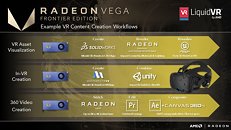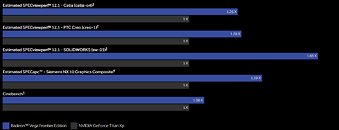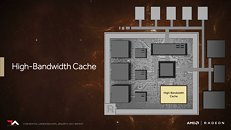Raevenlord
News Editor
- Joined
- Aug 12, 2016
- Messages
- 3,755 (1.24/day)
- Location
- Portugal
| System Name | The Ryzening |
|---|---|
| Processor | AMD Ryzen 9 5900X |
| Motherboard | MSI X570 MAG TOMAHAWK |
| Cooling | Lian Li Galahad 360mm AIO |
| Memory | 32 GB G.Skill Trident Z F4-3733 (4x 8 GB) |
| Video Card(s) | Gigabyte RTX 3070 Ti |
| Storage | Boot: Transcend MTE220S 2TB, Kintson A2000 1TB, Seagate Firewolf Pro 14 TB |
| Display(s) | Acer Nitro VG270UP (1440p 144 Hz IPS) |
| Case | Lian Li O11DX Dynamic White |
| Audio Device(s) | iFi Audio Zen DAC |
| Power Supply | Seasonic Focus+ 750 W |
| Mouse | Cooler Master Masterkeys Lite L |
| Keyboard | Cooler Master Masterkeys Lite L |
| Software | Windows 10 x64 |
It's here. The Radeon Vega that's not for gamers, that is. After what seems like a year of waiting forward to AMD's next generation GPU architecture, so it has finally appeared. As we all knew was going to be the case, Vega's first foray in the market is geared at the more profitable professional sector of the market. The good news for professionals: the pricing is lower than previously reported. Instead of the expected $1,199 and $1,799 for an air cooled or water-cooled version of the card respectively, AMD is commanding a much less demanding price tag of $999 for the air cooled version (available now) and $1,499 for the water-cooled one (to be available in Q3.)
One thing that deserves to be placed before the break is a software feature of the new Vega Frontier Edition graphics cards: AMD has changed their driver scheme into a single-package installer (available in the source), with both the professional-geared drivers, and the gaming ones as well. This means that after all that Raja Koduri told us to wait for AMD's consumer, gaming-oriented RX Vega graphics cards, these will probably work just as well for gaming as for professional workloads.



Now if true, this is a great value proposal for professionals (and that's how AMD is marketing it anyway, with a better, more streamlined workflow between game design and game testing), but also for general users who also partake in some professional workloads on the side. You can now get the equivalent of an AMD FirePro and an AMD Radeon in one card, which I must say, completely changes the status quo for professionals between AMD and NVIDIA. I only expect this software feature to be available in AMD's pro-geared graphics cards, however; this increases the value proposition for professionals, while ensuring AMD still has a professional product line where it can grab greater profits. This is a professional graphics card with gaming abilities, not the other way around; and the distinction is extremely important. For would-be early adopters, though, this could be great: if you don't mind paying a premium for what will ultimately be a slightly less performant version of AMD's top tier RX Vega (which should ship with higher clocks), maybe the Frontier Edition is your front door to AMD's latest architecture. Just do yourself a favor and make sure to do some digging around for gaming benchmarks before you commit ten Benjamins for it. That said, the "Frontier" tag in the card probably means AMD looks to this offering as a stepping stone between their gaming and professional graphics cards, while also dipping its toes on compute workloads; AMD will certainly build up a more focused line-up with their RX Vega and Instinct accelerators. The Frontier Edition seems to be a Titan Xp equivalent, at least when it comes to its footing on the professional/non gaming market: and that's exactly the card AMD is pitting it against.


Final specifications of the pioneer-geared graphics card point to a 1382 MHz base/typical clock, and a much more impressive 1600 MHz peak/boost clock, which drive the GPU's 4096 stream processors and 64 ROPs. It remains to be seen if the change in nomenclature actually means something; "typical clock" sounds to me as opening the door for the card to sometimes drop its frequency below that level. Single precision performance is rated by AMD at 13.1 TFLOPS, with a not surprising half-precision 26.2 TFLOPS of computing power being on offer (these are higher than the estimated computing performance AMD shared on the announcement slides for the Frontier Edition, by the way.) Further, the Frontier Edition's HBM 2 memory (which is probably the culprit for the release delays as AMD built up inventory) ticks at 1.89 Gbps, which, paired with the 2048-bit bus width, results in a very respectable 483 GB/s memory bandwidth.

The 483 GB/s memory bandwidth is slightly lesser than the original HBM 1 powered Fury, which delivered a full 512 GB/s, but AMD has some other, less brute force, more finesse-based technologies to work with, like HBC (High Bandwidth Cache) and its HBCC (High Bandwidth Cache Controller) companion. There's 16 GB of HBM 2 memory present on the card, and typical board power should be < 300 W. As to connectors, we've got the usual staples here: 3x DisplayPort 1.4 and 1x HDMI (all on the first slot, so as to increase air flow, which 300 W TDP on a blower-style fan needs all it can get.)
It's here, folks. Now to wait until July/August to hear more about the RX versions of this GPU.
View at TechPowerUp Main Site
One thing that deserves to be placed before the break is a software feature of the new Vega Frontier Edition graphics cards: AMD has changed their driver scheme into a single-package installer (available in the source), with both the professional-geared drivers, and the gaming ones as well. This means that after all that Raja Koduri told us to wait for AMD's consumer, gaming-oriented RX Vega graphics cards, these will probably work just as well for gaming as for professional workloads.



Now if true, this is a great value proposal for professionals (and that's how AMD is marketing it anyway, with a better, more streamlined workflow between game design and game testing), but also for general users who also partake in some professional workloads on the side. You can now get the equivalent of an AMD FirePro and an AMD Radeon in one card, which I must say, completely changes the status quo for professionals between AMD and NVIDIA. I only expect this software feature to be available in AMD's pro-geared graphics cards, however; this increases the value proposition for professionals, while ensuring AMD still has a professional product line where it can grab greater profits. This is a professional graphics card with gaming abilities, not the other way around; and the distinction is extremely important. For would-be early adopters, though, this could be great: if you don't mind paying a premium for what will ultimately be a slightly less performant version of AMD's top tier RX Vega (which should ship with higher clocks), maybe the Frontier Edition is your front door to AMD's latest architecture. Just do yourself a favor and make sure to do some digging around for gaming benchmarks before you commit ten Benjamins for it. That said, the "Frontier" tag in the card probably means AMD looks to this offering as a stepping stone between their gaming and professional graphics cards, while also dipping its toes on compute workloads; AMD will certainly build up a more focused line-up with their RX Vega and Instinct accelerators. The Frontier Edition seems to be a Titan Xp equivalent, at least when it comes to its footing on the professional/non gaming market: and that's exactly the card AMD is pitting it against.


Final specifications of the pioneer-geared graphics card point to a 1382 MHz base/typical clock, and a much more impressive 1600 MHz peak/boost clock, which drive the GPU's 4096 stream processors and 64 ROPs. It remains to be seen if the change in nomenclature actually means something; "typical clock" sounds to me as opening the door for the card to sometimes drop its frequency below that level. Single precision performance is rated by AMD at 13.1 TFLOPS, with a not surprising half-precision 26.2 TFLOPS of computing power being on offer (these are higher than the estimated computing performance AMD shared on the announcement slides for the Frontier Edition, by the way.) Further, the Frontier Edition's HBM 2 memory (which is probably the culprit for the release delays as AMD built up inventory) ticks at 1.89 Gbps, which, paired with the 2048-bit bus width, results in a very respectable 483 GB/s memory bandwidth.

The 483 GB/s memory bandwidth is slightly lesser than the original HBM 1 powered Fury, which delivered a full 512 GB/s, but AMD has some other, less brute force, more finesse-based technologies to work with, like HBC (High Bandwidth Cache) and its HBCC (High Bandwidth Cache Controller) companion. There's 16 GB of HBM 2 memory present on the card, and typical board power should be < 300 W. As to connectors, we've got the usual staples here: 3x DisplayPort 1.4 and 1x HDMI (all on the first slot, so as to increase air flow, which 300 W TDP on a blower-style fan needs all it can get.)
It's here, folks. Now to wait until July/August to hear more about the RX versions of this GPU.
View at TechPowerUp Main Site
Last edited:




 00 W.
00 W.




